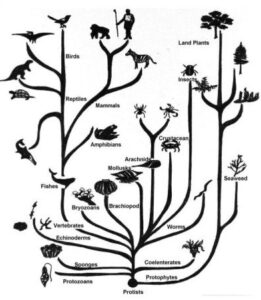When discussing the Darwinian theory of evolution, it is easy to get bogged down in a variety of details and definitions that are unrelated and unhelpful to the specific point we are trying to address. This is because, while it is one wholistic theory, Darwinian evolution involves a number of distinct claims which can (and often should) be discussed and weighed separately on their own merits. As one biologist notes:
“Darwin’s theory has to be sifted carefully, because it isn’t just a single concept – it actually is a mixture of several unrelated, entirely separate ideas.”1
While the issues are not always quite as “unrelated” and “entirely separate” as the above quote implies, there is still an important truth here. While one can (and sometimes should) evaluate and critique the theory of evolution as a whole and challenge it as a complete thesis, it can also be helpful to subdivide it into its key claims and address them individually. This helps to clarify exactly what you are disagreeing with at the moment and why. It gives the conversation focus.
There are several accurate ways to do this. Here, I offer three essential claims that comprise the core of Darwinian evolution. None of these claims, by itself, is Darwinism. A person can (and many do) agree with one or two of these claims without being a Darwinist. Yet, if any of these claims are false, then the whole of Darwinian evolution breaks down. Thus, it is often constructive to choose just one of these theses and focus the conversation there.
Decent with modification (not Just Darwinian)
This claim is uncontroversial and virtually undisputed. It is merely the claim that organisms alive today are descended from earlier organisms, but with changes or modifications that occurred over time. The dogs, parrots, and butterflies we see alive in our era came from ancient ancestors that in many cases looked meaningfully different than any modern, living example. People long before Darwin already knew this, and biblical creationists enthusiastically affirm it, pointing out that Genesis itself teaches that creatures would reproduce “after their kind” (Genesis 1:24-25, etc.), which seems to imply certain flexibility and variation within defined categories or “kinds” of organisms.
Thus, decent with modification, in and of itself, is not a matter of debate. It is necessary for this to be true if Evolution is to be true, but decent with modification is not, by itself, Darwinian evolution. The biological “theory of evolution” implies much more than this. Not only do Darwin’s critics agree on “descent with modification”, but so did most everyone before there was a Darwin to criticize. It’s practically a truism.
We need to keep this in mind as many of Darwin’s defenders will (whether intentionally or carelessly) point to examples of this as proof of Darwinism. Others claim that the theory of evolution simply means “change over time” and thus insist that, by accepting decent with modification you are obligated to accept Darwinism as a whole. These rhetorical moves are false and unhelpful distractions, but they happen often. To keep the conversation fruitful for all involved, it is important to pay attention and be aware that they are actually sidestepping the issue by defending the one pillar of Darwinism that you are most certainly not challenging. This is exactly why focusing the discussion on something more specific within evolutionary theory can often be more productive than broadly discussing “evolution” as a whole.
Common ancestry (the Darwinian story)
This is perhaps the most “stereotypic” claim within Darwinian evolution (i.e., it is frequently what first comes to people’s minds when they think of “Darwinism” or “Evolution.”) It is the assertion that all living things on earth (whether plant, animal, fungus, or microbe) are descended from a common single-celled ancestor. It structures the history of all organisms into a “tree of life,” starting with one simple, original kind of organism and branching out over time into various distinct categories until we reach the wide variety of species we have today.
 Thus, according to common ancestry, today’s humans are one branch of the ape family, going back to a common ancestor shared with chimpanzees, gorillas, etc. The apes, in turn, share a common proto-primate ancestor with monkeys and lemurs, which in turn share an earlier proto-mammal ancestor with dogs, rats, elephants, giraffes, etc. Still earlier, we mammals allegedly came from a branch of the reptile family (birds having their roots in a different group of reptiles, and thus being our very distant cousins.) If we continue back even further, we find how the reptiles and amphibians (like frogs and salamanders) are related, how they go back to distant common ancestors shared with the fish, who in turn share a common ancestor with the early invertebrates that went on to become our insects, crustaceans, and the like. Go back far enough, and this model claims that you find a thread that connects us to the organisms that also gave birth to jellyfish, mollusks, sponges, etc. Yet earlier still in the expanse of time, all animals go back to the earliest multicellular organisms that also gave rise to plants and fungi. Those, in turn, arose from still earlier single-celled organisms, ultimately going back to the very first cell. Common ancestry, by itself, makes no claim as to where that first cell itself came from. Only that its offspring gave rise to all other livings things on earth.
Thus, according to common ancestry, today’s humans are one branch of the ape family, going back to a common ancestor shared with chimpanzees, gorillas, etc. The apes, in turn, share a common proto-primate ancestor with monkeys and lemurs, which in turn share an earlier proto-mammal ancestor with dogs, rats, elephants, giraffes, etc. Still earlier, we mammals allegedly came from a branch of the reptile family (birds having their roots in a different group of reptiles, and thus being our very distant cousins.) If we continue back even further, we find how the reptiles and amphibians (like frogs and salamanders) are related, how they go back to distant common ancestors shared with the fish, who in turn share a common ancestor with the early invertebrates that went on to become our insects, crustaceans, and the like. Go back far enough, and this model claims that you find a thread that connects us to the organisms that also gave birth to jellyfish, mollusks, sponges, etc. Yet earlier still in the expanse of time, all animals go back to the earliest multicellular organisms that also gave rise to plants and fungi. Those, in turn, arose from still earlier single-celled organisms, ultimately going back to the very first cell. Common ancestry, by itself, makes no claim as to where that first cell itself came from. Only that its offspring gave rise to all other livings things on earth.
This is a foundational component of Darwinian evolution, yet even this, by itself, is not the Darwinian theory of evolution. Many before Darwin already believed in common descent. Indeed, many in the Intelligent Design (ID) movement who are vocal critics of Darwinism actually affirm and defend common descent. Thus, to prove the Darwinian theory of evolution, the Darwinist must prove more than common descent. Still, common descent is absolutely central and necessary to Darwin’s theory. If common descent is refuted, Darwinism immediately falls with it.
For this reason, many biblical Christians choose this as the central battleground, and understandably so. The ID movement, which is concerned only with the scientific hypothesis that an intelligent cause of some kind lies behind certain aspects of the natural world, is fully compatible with common descent. Likewise, a bare “theism” that generically believes in an ultimate “God” behind the universe but claims no revelation from that God is unharmed if all life is related in this way. Biblical Christianity, however, asserts that God made known to us through His prophets certain truths about His act of creation, and those truths contradict the common descent narrative on which Darwinism depends. Thus, while other Darwin critics can accept common descent and battle evolutionary theory elsewhere, the biblical Christian (whose goal is not merely to refute Darwin but rather to proclaim the triune Creator of the universe) must at some point take up the debate here. Still, that doesn’t mean every conversation about evolution needs to be about common descent. There is another pillar of Darwin’s theory well worth taking up.
Sufficiency of Naturalistic Processes (the means of evolution)
The crux of Darwinian evolutionary theory is not merely the fact of descent with modification or even the attempt to extrapolate this back to the alleged common descent of all organisms. As we have noted, some other rival theories also affirm all of that. Darwinism’s distinctive is the claim that a specific set of entirely blind, purposeless, naturalistic processes brought all of this about gradually over a very long period of time. Chief among these is natural selection acting on random variations, though other additional mechanisms are sometimes proposed as working in tandem with these core processes (so long as these additional mechanisms are also entirely unplanned, unthinking, and purely naturalistic).
Essentially, Darwin noted that organisms randomly vary over time (Mendel was just discovering genetics during Darwin’s lifetime, and the discovery of DNA was still a long time off, so “genetic mutation” as the source of this variation was not yet known to Darwin himself, but would be adopted by Darwinists once the science developed). Darwin then proposed the mechanism of “natural selection,” a process by which variations that are beneficial in a given environment survive and reproduce while unhelpful variations die or fail to produce offspring and thus are eliminated from future generations. Thus, according to Darwin, natural selection acting on random variation (now understood to be random genetic mutations) would slowly shape organisms over time to develop a continuous stream of adaptations to their environments. As those environments changed, or as the organisms multiplied and spread into new environments, selection would then favor different kinds of variation, leading to different changes in the organisms. In this way, gradually over a very long period of time, Darwin believed (and his followers still believe) that natural selection acting on random mutation could explain the development of every form of life on earth.
Thus, as different as bats might look from palm trees, as different as feathers are from rose pedals, all of these creatures and their various structures and organs are the chance results of a blind process of mutation and natural selection over billions of years. Or at least, that’s what evolutionary theory tells us. While some Darwinian scholars have proposed additional (also blind and naturalistic) processes that may also have contributed along the way, natural selection acting on random mutation remains the core of the Darwinian narrative. At any rate, any version of this story requires that all of the processes involved be entirely unplanned, purposeless, and completely naturalistic. If any intelligence, purpose, or guiding principle was involved, Darwinism is false.
This is the major distinguishing factor that separates Darwinian theory from Intelligent Design. Design theorists often accept the general Darwinian story of the common ancestry of all living creatures, but they take issue with the idea that naturalistic processes like random mutation and natural selection are sufficient to explain the vast, complex, and specified changes that it would have taken to move from a single bacterium to a world of hummingbirds, venus fly traps, mushrooms, and men. These ID researchers demonstrate that there are limits to both the kind and the degree of change that Darwinian processes can produce.2 They also point out the existence of complex systems that require all of their parts complete and in place before they can function. Such systems would never form piece by piece in a blind, Darwinian fashion.3 In these and other such ways, Intelligent Design advocates argue that blind, naturalistic mechanisms are not enough. genetic mutation and natural selection are real, but there are clear limits to what they can do, and the reality of life around us exceeds those limits. Indeed, design theorists argue that there is demonstrable evidence of planning, purpose, and inteligence in the development of life that cannot be explained by any blind, purely naturalistic process.
As a biblical Christian, I cannot just accept “common descent” the way many ID theorists do. I can, however, temporarily put the issue aside so as to have a focused conversation on naturalism. I can say something like, “for the sake of argument, let’s just assume for the moment that every creature on earth really did descend from a single microbial ancestor. Even given your common descent narrative and your proposed timeline, it is still not possible that Darwinian processes could have brought all of this about.” Once I show that their view, even taken on its own terms, doesn’t work, I can then step back and challenge the basis of their common descent narrative (either immediately or, more often, in a later conversation), or, while challenging them to accept the implications of the fact that naturalistic, godless causes cannot explain what we see around us, I can move more directly to a gospel conversation.
Conclusion: Addressing Darwinian claims
Evolutionary theory is a big topic, but it contains within it several smaller topics that are worth discussing on their own. While it can be useful to discuss the whole Darwinian worldview together in a “big picture” way, it is also sometimes valuable to isolate one specific, central claim within the theory of Evolution and discuss that in a focused manner, especially when that narrower topic is a pillar on which the whole Darwinian edifice rests. Common descent and the sufficiency of naturalistic processes are two such topics that Christians might find useful to take up. Our goal, however, should never be merely to bring Darwinism down, but rather to uphold biblical truth and proclaim Christ and Him crucified.
References
| 1↑ | Michael Behe, The Edge of Evolution (Free Press, 2007) 1 |
|---|---|
| 2↑ | See, for example, Michael Behe’s book “The Edge of Evolution“ |
| 3↑ | Michael Behe provides a great example of this line of research as well in his work “Darwin’s Black Box.” |






